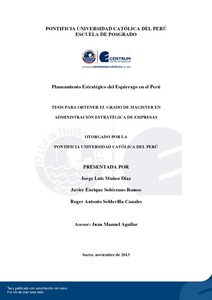| dc.contributor.advisor | Aguilar Rengifo, Juan Manuel | |
| dc.contributor.author | Muñoz Díaz, Jorge Luis | es_ES |
| dc.contributor.author | Solórzano Ramos, Javier Enrique | es_ES |
| dc.contributor.author | Soldevilla Canales, Roger Antonio | es_ES |
| dc.date.accessioned | 2017-05-30T22:46:43Z | |
| dc.date.available | 2017-05-30T22:46:43Z | |
| dc.date.created | 2013 | |
| dc.date.issued | 2017-05-30 | |
| dc.identifier.uri | http://hdl.handle.net/20.500.12404/8711 | |
| dc.description.abstract | El Perú es el primer exportador de Espárrago del Mundo, se comercializa
principalmente al mercado americano y europeo por su alta calidad; la variedad de
microclimas permite que esta hortaliza se coseche durante todo el año, lo que constituye que
el Perú sea considerado un país con ventajas de abastecimiento, respecto de otros países.
Para alcanzar la Visión al 2023, se deben lograr los siguientes objetivos de largo
plazo: (a) Las exportaciones peruanas de Espárragos serán de US$ 757 millones; (b) El Perú
tendrá una participación de mercado del 15% sobre las exportaciones mundiales de
espárragos congelados; (c) El consumo nacional alcanzará las 15,000 toneladas que
representa el 5% de la producción nacional; (d) El 70% de las plantaciones de espárrago
contará con un sistema de monitoreo meteorológico para controlar las variables ambientales y
producir espárragos de alta calidad; (e) El incremento promedio anual en el índice de costos
de la industria será inferior al 2.5% y (f) En el 2023 el Perú cultivará espárragos con un
rendimiento superior a las diez toneladas por hectárea.
El crecimiento del sector ha empezado en la década de los noventa y hoy sigue en
ascenso a pesar de atravesar la crisis mundial de 2008 y 2009, que produjo el estancamiento
de las exportaciones, pero nuevamente está en proceso de crecimiento.
Este análisis ha permitido seleccionar estrategias para la solución de los problemas que
tiene la industria de espárragos en nuestro país. Dentro de las estrategias retenidas tenemos las
siguientes: (a) Incrementar el consumo interno a través de supermercados, recetarios;
(b) Monitorear los cultivos; (c) Priorizar la comercialización de espárragos frescos; (d) Invertir
en tecnología y sistemas de información; (e) Capacitar técnicamente a los productores.
Respecto de las estrategias de contingencia: (a) Construir infraestructura tipo invernadero para
controlar las condiciones del cultivo; (b) Crear certificaciones que garanticen la calidad de los
insumos que se utilizan y (c) Reparar o construir vías de comunicación que conecten las zonas
de cultivo con sus mercados o puerto de embarque.
La implementación de estas estrategias está ligada a la Misión, Visión y a los objetivos
de largo plazo definidos en el proyecto y permitirán lograr las metas trazadas hacia el 2023 | es_ES |
| dc.description.abstract | Peru is the first Asparagus exporter in the World, it is commercialized principally to
the American and European market by its high quality; the diverse microclimates variety
does that this vegetable takes place (is produced) throughout the whole year, which does
that Peru is considered a Country with supplying advantages to the World with respect to
other countries.
To reach the Vision 2023, the following long term targets must be gotten: (a) The
Peruvian exports of Asparagus will be of US$ 757 millions, (b) Peru will have a market
participation of 15 % on the world exports of frozen asparagus, (c) The national consumption
will reach 15:000 tons that it represents 5 % of the national production, (d) 70% of the
plantations of asparagus will be provided(rely on) with system of meteorological monitoring
to control the environmental variables and to produce asparagus of high quality, (e) The
annual average increase in the index of costs of the industry will be lower than 2.5 %, and (f)
In the 2023 national in Peru where plants asparagus will yield exceeding 10 tonnes per
hectare
The growth of the sector has started in the 90s and today it continues in ascent
although the year 2008 and 2009 it present the world crisis, which produced the stagnation of
the exports, but again it is in growth process.
The analysis allowed us to select strategies for the solution of the problems that has
the asparagus industry in our country. Regarding contingency strategies we have: Increase the
internal consumption through supermarkets, cookbooks; monitoring of the cultivation; to
prioritize the commercialization of fresh asparagus, technological investment, investment in
information systems, technical training to producers. On the other hand, the risk strategies are
the following ones: Build infrastructure type greenhouses to control the conditions of the
cultivation, to Create certifications that guarantee the quality of the inputs that are used and to
repair or build routes of communication that connect the cultivation areas with their markets
or port of shipment.
The implementation of these raised strategies is tied to Mission, Vision and the targets
of long term raised in the project and they will make it possible to get the targets about 2023 | es_ES |
| dc.language.iso | spa | es_ES |
| dc.publisher | Pontificia Universidad Católica del Perú | es_ES |
| dc.rights | Atribución-NoComercial-SinDerivadas 2.5 Perú | * |
| dc.rights | info:eu-repo/semantics/openAccess | es_ES |
| dc.rights.uri | http://creativecommons.org/licenses/by-nc-nd/2.5/pe/ | * |
| dc.subject | Espárragos -- Industria y comercio -- Perú | es_ES |
| dc.subject | Alimentos -- Industria y comercio -- Perú | es_ES |
| dc.subject | Planificación estratégica | es_ES |
| dc.title | Planeamiento estratégico del espárrago en el Perú | es_ES |
| dc.type | info:eu-repo/semantics/masterThesis | es_ES |
| thesis.degree.name | Magíster en Administración Estratégica de Empresas | es_ES |
| thesis.degree.level | Maestría | es_ES |
| thesis.degree.grantor | Pontificia Universidad Católica del Perú. CENTRUM | es_ES |
| thesis.degree.discipline | Administración Estratégica de Empresas | es_ES |
| renati.discipline | 413307 | es_ES |
| renati.level | https://purl.org/pe-repo/renati/level#maestro | es_ES |
| renati.type | https://purl.org/pe-repo/renati/type#tesis | es_ES |
| dc.publisher.country | PE | es_ES |
| dc.subject.ocde | https://purl.org/pe-repo/ocde/ford#5.02.04 | es_ES |






